From rainforests in South America to rustic countrysides in the United States, there are so many marvelous birds to discover. Whether you’re searching for an exotic bird or a more elusive species, the world of birds that start with Q offers a vast array of unique and dazzling birds. So, grab your binoculars, and let’s jump right in!
1. Quetzal (Trogon)
One of the most dazzling birds that start with Q is the colorful quetzal bird. Most of these eye-catching creatures live in neotropical regions. However, the eared quetzal (Euptilotis neoxenus) is native to Guatemala, where it is also the country’s national bird. Quetzal birds are around 13 inches long with striking and brightly colored feathers.
Their wings, chests, and heads are a rich green or golden green color, while their bellies are a vibrant red. These colors allow them to blend in with their surroundings when it rains, camouflaging and seamlessly with the wet and shiny green habitats. Male quetzal birds boast impressively long tails, with some growing up to 35 inches long!

Once they reach maturity, it can take up to three whole years for a male quetzal’s tail to grow to its full length.
©iStock.com/Carole Palmer
2. Quail (Galliformes)
Small and plump, quails kind of look like little miniature partridges with short tails and speckled coats. They typically prefer being in open areas or bushy borders with plenty of hiding spots. There are over 130 species of quail, consisting of both New World quail and Old World quail.
New World quails tend to have stronger bills, while Old World quails are smaller and stockier. The common quail (Coturnix coturnix), also known as the European quail, is commonly raised as a game bird for hunting.
One of the common types of New World quails in the western United States is the California quail (Callipepla californica). These beautiful birds have a unique crest or plume made of six feathers that curve out from the top of their heads. Their feathers have stunning patterns with gray-blue, brown, and white colors.
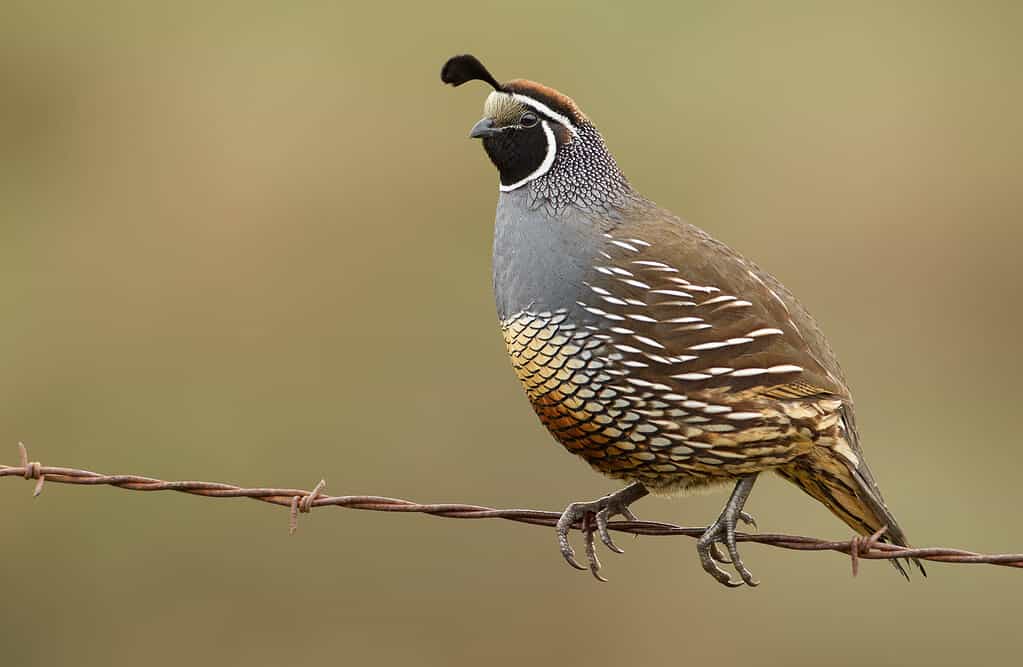
The California quail is the official state bird of California.
©Agnieszka Bacal/Shutterstock.com
3. Quail-Plover (Ortyxelos meiffrenii)
These little ground-dwelling birds live in Africa, where they often skulk and sneak through grassy areas. Quail-plovers are 7 to 8 inches long and are very vocal birds. They have sandy, reddish-brown colored feathers on their backs and white feathers on their bellies. When they take flight, however, they flutter like larks, revealing white primary feathers that starkly contrast with white-tipped black feathers. This creates a unique diagonal band on the upper part of the bird’s wings. Female quail-plovers are a little darker than male birds, and juvenile quail-plovers have paler feathers.
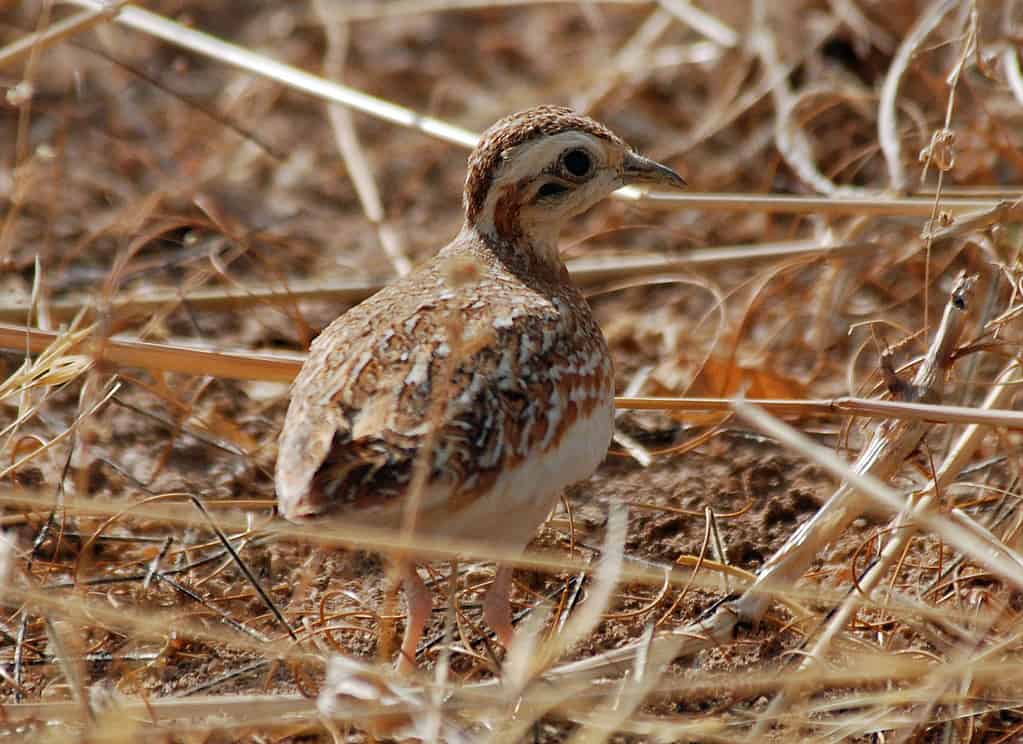
The quail-plover is also called the lark-plover or the lark buttonquail.
©Nigel Voaden / CC BY-SA 2.0 – License
4. Quelea (Quelea quelea)
This dazzling bird that starts with Q is known as the quelea, red-billed quelea, red-billed dioch, or red-billed weaver. They are unique weaver birds that live in Sub-Saharan Africa, where they can be found flying in large flocks across the savanna. They mostly eat seeds from annual grasses. However, they can also cause significant damage to cereal crops and are sometimes referred to as “ Africa’s feathered locust”. Red-billed queleas are considered the most abundant wild birds in the world. After breeding, these birds gather in enormous flocks that sometimes reach up to 1.5 billion individuals!
Quelea birds kind of look like sparrows, measuring just 4.7 inches long on average. They have distinctive red, cone-shaped bills that are heavy and sturdy. During the breeding season, the female’s bill transitions to a bright orange or yellow color.

Both male and female queleas have red bills outside of the breeding season, making it hard to tell them apart.
©Humpata/Shutterstock.com
5. Quaker Parrot (Myiopsitta monachus)
These colorful little gems of the bird world have bright green feathers with a grayish breast and a greenish-yellow belly. Quaker parrots aren’t too big, measuring around 11 inches long on average, but they do have an impressive wingspan of 19 inches. They also have a long and tapering tail and a bright orange bill.
Quaker parrots originally come from the temperate to subtropical areas of South America. However, they have made their way into new territories and now have self-sustaining feral populations in North America and Europe. Quaker parrots are also common in the pet world, where they are sometimes referred to as monk parakeets. These incredible birds are very social and intelligent and can learn fairly large vocabularies.

Quaker parrots are highly social, intelligent, and quick to grasp human vocabulary.
©Foto 4440/Shutterstock.com
6. Quail Dove (Geotrygon)
Living in the lush and vibrant regions of the neotropics, the quail dove is found from southern Mexico and Central America all the way to the West Indies and South America. These ground-dwelling birds make their homes in dense forests. They have stunning purple to brown feathers, paired with light and dark facial markings.
Quail doves look similar to quails, but they are not closely related. However, they are about the same size as a quail, with short legs and tails. Their feathers typically range from shades of brown to gray, but some species also have stunning iridescent markings.
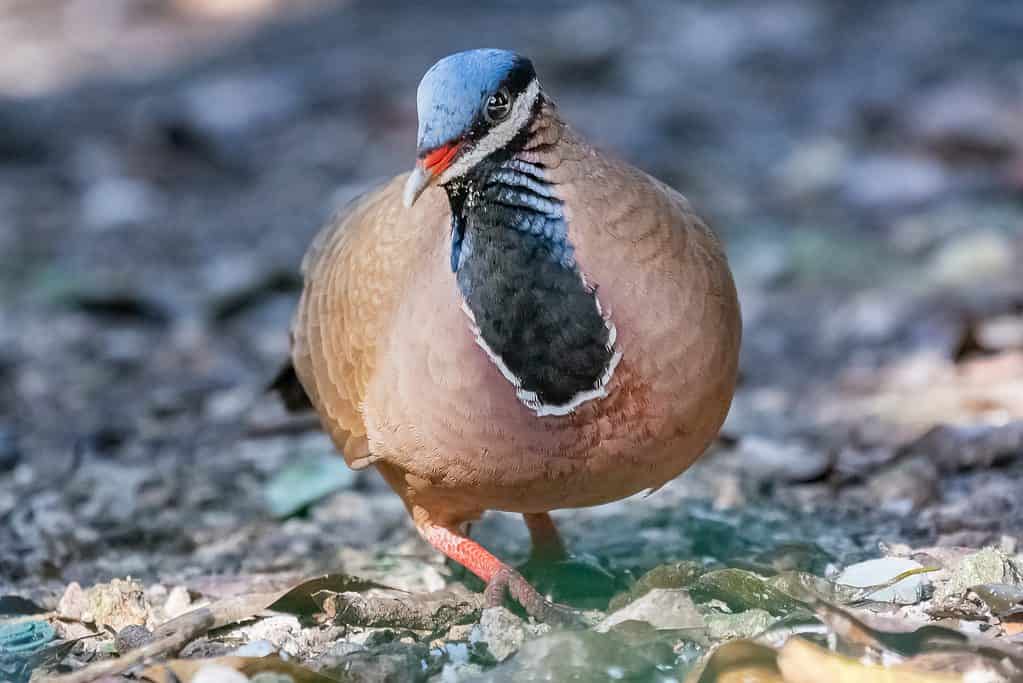
The quail dove’s scientific name,
Geotrygon, means “ground turtledove”.
©Piotr Poznan/Shutterstock.com
7. Queen Victoria Riflebird (Lophorina victoriae)
The Queen Victoria riflebird is a stunning member of the bird-of-paradise family. It can only be found in the Atherton Tableland region of Northeastern Queensland in Australia. The bird’s name comes from Queen Victoria, as well as the British Army Rifle Brigade, as the bird’s striking and velvety black feathers resemble the Brigade’s uniform. Queen Victoria riflebirds are the smallest type of riflebird, measuring between 9 and 9.8 inches.
Male Queen Victoria riflebirds are especially flamboyant, with feathers that have a purple sheen. The color becomes more blue-green on their heads and more brown on their lower breasts. There is also a metallic green and blue triangular patch in the center of their velvety black throats. When courting, male birds show off this impressive plumage. With his rounded wings curved above his body, the bird tilts his head back to expose his chin and throat to the light and then moves from side to side in an almost mechanical dance.
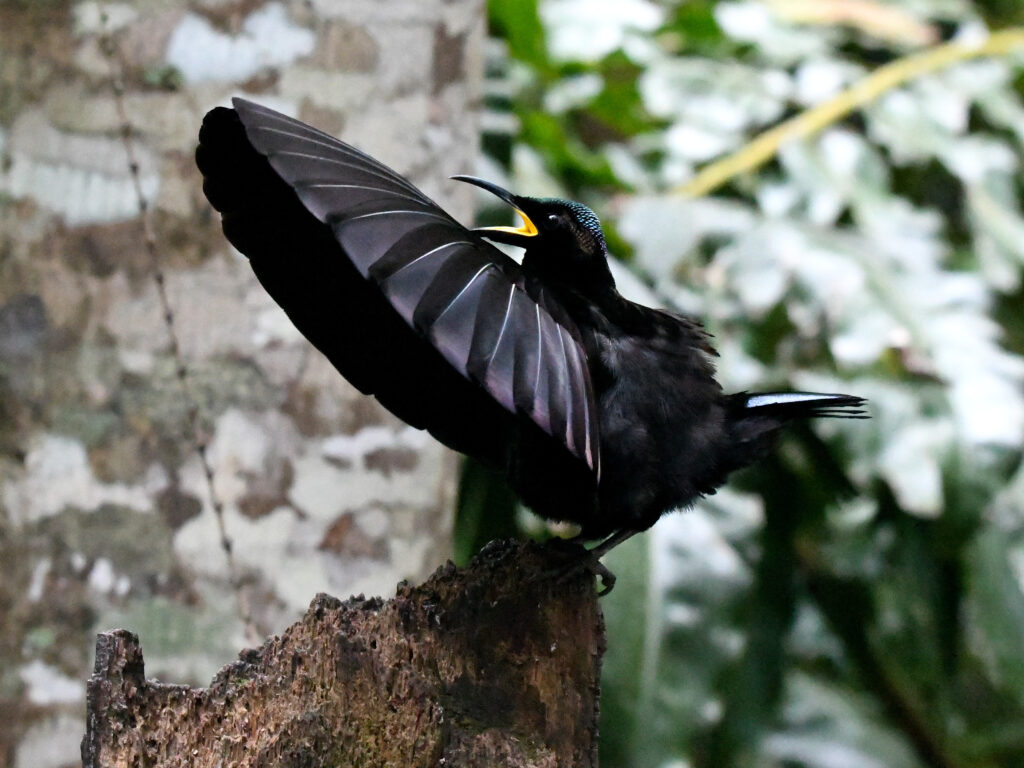
Unfortunately, Queen Victoria riflebirds are vulnerable species according to the IUCN Red List.
©Dirk Kotze/Shutterstock.com
8. Quailfinch (Ortygospiza atricollis)
The quailfinch is a petite and charming little bird that starts with Q living in open grassland areas in Africa. Measuring only 4.7 inches long and weighing 0.5 to 0.7 ounces, it is a much smaller songbird. However, don’t let the birds’ small size fool you — they still have plenty of personality!
Quailfinches are social birds who love to hang out with their fellow feathered friends. You might spot them in groups of up to 50 birds, chirping away and flitting about. The quailfinch has brown feathers on its back and white feathers on its underbelly. Its striking black face features white eye rings, almost as if it is wearing a pair of glasses. It has a vibrant red bill and a short, pointed tail.

Quailfinch are very terrestrial birds, which means they spent a lot of time on the ground.
©JMx Images/Shutterstock.com
9. Quebracho Crested Tinamou (Eudromia formosa)
Although they can fly, quebracho crested tinamous aren’t the strongest flyers of the bird world. They are shy birds and prefer to use their quick reflexes to run away from predators. Quebracho crested tinamous live in the savannah and dry forest habitats of Paraguay as well as in the northern regions of Argentina.
They are about 15 inches long with patterned plumage that provides excellent camouflage. These fascinating birds have grayish-brown to blackish feathers on their back with scattered white spots. Their undersides are pale buff to white with black bar patterns. One of their most unique features, however, is the long crest atop their heads — it looks like a fantastic spiky hairdo!
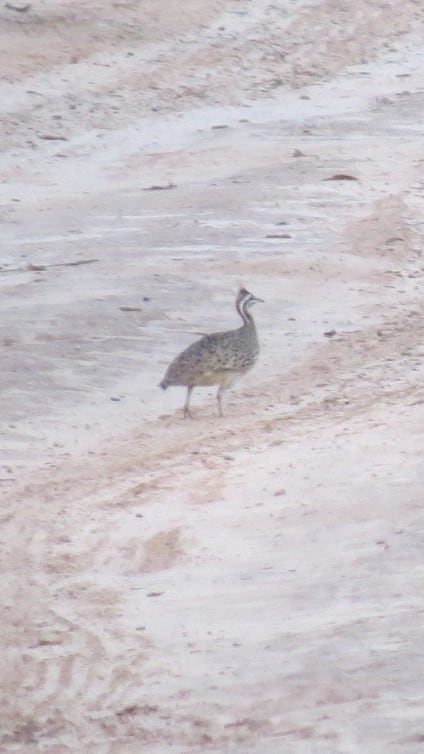
Quebracho crested tinamous much prefer to run away from predators rather than fly or defend.
©Rob Foster / CC BY 4.0 – License
10. Quail Thrush (Cinclosoma)
Found in New Guinea and Australia, quail thrushes are ground-dwelling birds with chestnut or brown feathers on their backs and striking black and white markings on their wings. Their faces are uniquely marked with black and white patterns as well, giving them a distinctive and eye-catching appearance. Quail thrushes can live in many different types of habitats, from deserts to woodlands and rainforests.
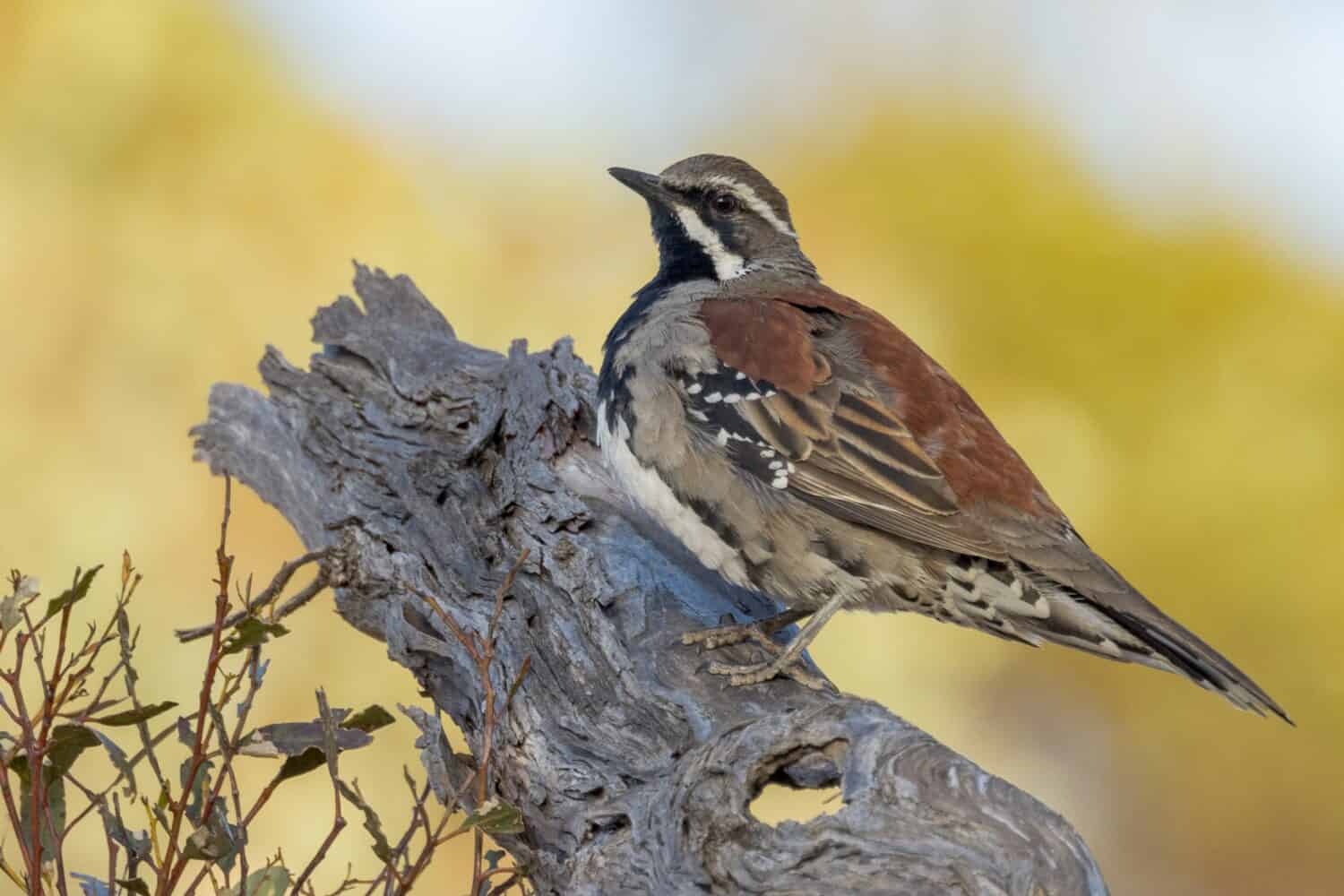
Quail thrushes are omnivores and eat fruits, seeds, and
insects
.
©Imogen Warren/Shutterstock.com
11. Queen Whydah (Vidua regia)
The next dazzling bird that starts with Q on our list is the queen whydah (or shaft-tailed whydah) in Africa. These sparrow-like birds live in open habitats and grasslands across South Africa, stretching all the way from southern Angola to southern Mozambique. During the breeding season, male birds have a rather regal appearance, sporting striking black crown and upper body feathers, a golden breast, and four extra long black tail feathers with uniquely expanded tips. However, after the breeding season, the male sheds his glorious tail and grows brown feathers like a female queen whydah bird.
One of the most interesting things about the queen whydah bird is that it is a brood parasite to the violet-eared waxbill (Granatina granatina). In other words, this crafty little bird lays its eggs in the nests of other birds, leaving the host birds to raise its babies!
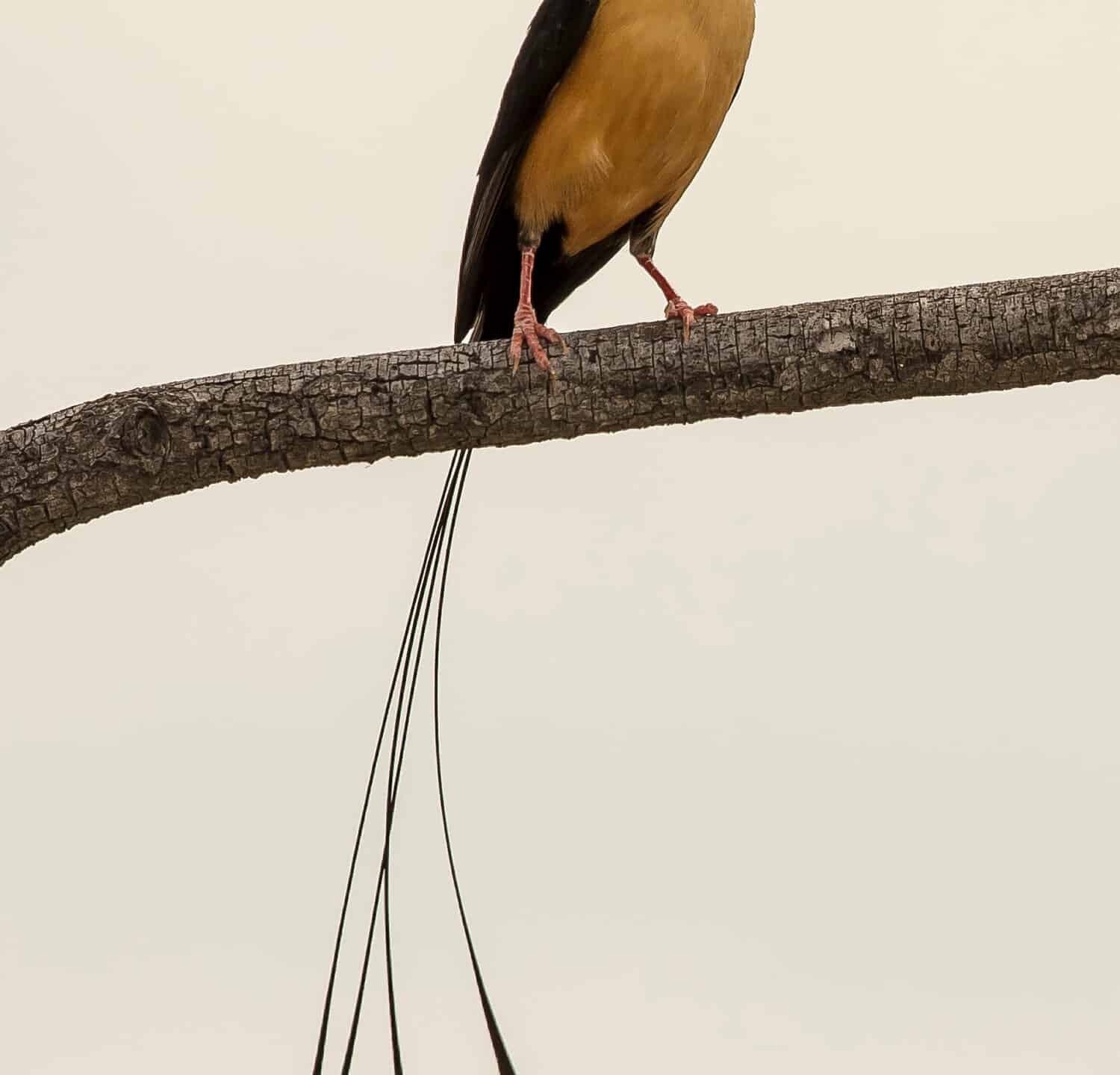
After the breeding season, it can be difficult to tell male and female queen whydah birds apart.
©Frank McClintock/Shutterstock.com
12. Quailfinch Indigobird (Vidua nigeriae)
Like the Queen Whydah bird, the quailfinch indigobird is also a brood parasite. This fascinating bird lays its eggs in the nests of African quailfinches (Ortygospiza atricollis fuscocrissa), who then raise them as their own.
Quailfinch indigobirds live in West Africa, but we don’t know a ton about these small songbirds. Males have a stunning greenish-blue shimmer on their feathers, with a pale brownish panel that can be seen when they fly. Their beaks and legs are a whitish color, which contrasts beautifully against the birds’ black-colored bodies. Females are not quite as flashy, but they are still worth admiring. They have streaky brown patterns on their backs with pale undersides, and a bold, eye-catching facial pattern.
13. Queen Carola’s Six-Wired Bird-of-Paradise (Parotia carolae)
Named after Queen Carola of Vasa, Queen Carola’s six-wired bird-of-paradise (or Carola’s parotia) is native to New Guinea. The male birds are especially colorful, with black bodies and white flanks, a golden throat, and a chest covered in beautiful bronze scales. They also have six feathers shooting out from the back of their heads little antennae. Female birds are smaller than males, but they have longer tails. Their flanks are a rusty color, and they have grayish-brown bodies and unique black and white stripes on their faces.
Just as impressive as the birds’ appearance is the males’ unique courting performance. He starts by building a small platform on the ground, using his creativity to decorate it with flowers, leaves, and other beautiful objects. Once this stage is set, he begins a series of spectacular dances. With his wings spread wide, he fans his tail feathers and raises his regal head plumes with pride. And what’s even more impressive is that he can keep dancing for up to 30 minutes!

Queen Carola of Vasa was the last Queen consort of Saxony. She was married to King Albert I of Saxony.
©Helmy oved / Public Domain Mark 1.0 – License
The Largest Bird That Starts With Q
The resplendent quetzal (Pharomachrus mocinno) is the largest bird that starts with Q, measuring 14 to 16 inches in length — and that’s not even including their incredibly long tails! Male resplendent quetzals have tail feathers that can extend a staggering 2 feet in length! This incredible tail is what gives the bird the name “quetzal”, which is derived from the Nahuatl word “quetzalli” meaning “ tail feather”.
These breathtakingly beautiful birds live in the cloud forests high up in the mountains of southern Mexico and Central America. They carry significant cultural weight in many parts of Central America. In Guatemala, the bird holds a special place as the national symbol and is even seen on the country’s flag and currency. Unfortunately, the resplendent quetzal is a near-threatened species.

The resplendent quetzal is an important symbol in both Aztec and Mayan culture and is associated with the feathered serpent god, Quetzalcoatl.
©Ondrej Prosicky/Shutterstock.com
The Fastest Bird That Starts With Q
The California quail (Callipepla californica) is the fastest bird that starts with Q, with an ability to fly 30 to 40 miles per hour on average. However, despite this impressive velocity, California quails are not known for their strong flying abilities. Instead, these birds prefer to trot along the ground, usually in family groups with other quail.
But when danger strikes, California quails take to the skies with swift, short flights that are perfectly suited for their broad and stubby wings. You will always know when California quails are flying — the sound of their whirring wings is quite loud!

California quail are not built to fly for long periods of time, but when necessary, these chubby little birds can burst through the air at 30 to 40 miles per hour!
©iStock.com/Banu R
Summary of Dazzling Birds That Start With Q
| Common Name | Scientific Name |
|---|---|
| Quetzal | Trogon |
| Quail | Galliformes |
| Quail-Plover | Ortyxelos meiffrenii |
| Quelea | Quelea quelea |
| Quaker Parrot | Myiopsitta monachus |
| Quail Dove | Geotrygon |
| Queen Victoria Riflebird | Lophorina victoriae |
| Quailfinch | Ortygospiza atricollis |
| Quebracho Crested Tinamou | Eudromia formosa |
| Quail Thrush | Cinclosoma |
| Queen Whydah | Vidua regia |
| Quailfinch Indigobird | Vidua nigeriae |
| Queen Carola’s Six-Wired Bird-of-Paradise | Parotia carolae |
| Quetzal: Resplendent Quetzal | Pharomachrus mocinno |
| Quail: California Quail | Callipepla californica |
The photo featured at the top of this post is © Linn Currie/Shutterstock.com
Thank you for reading! Have some feedback for us? Contact the AZ Animals editorial team.







